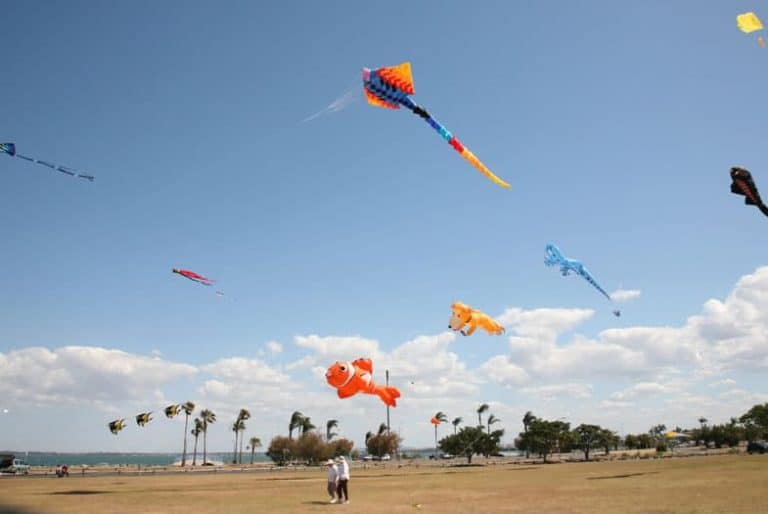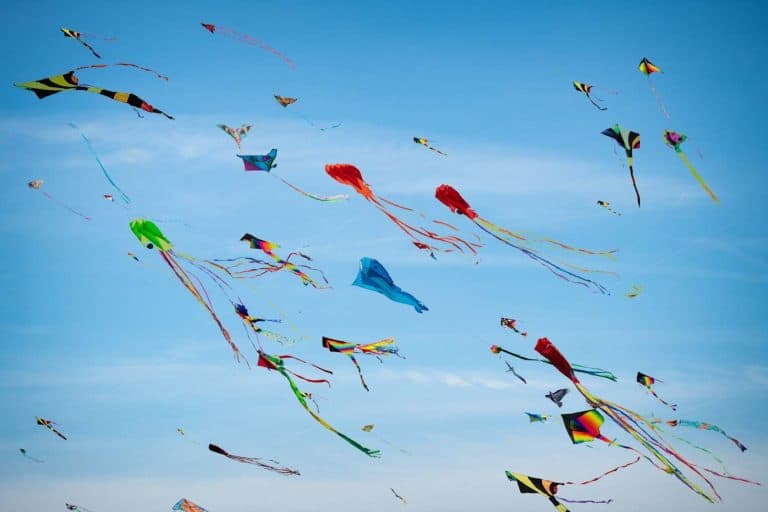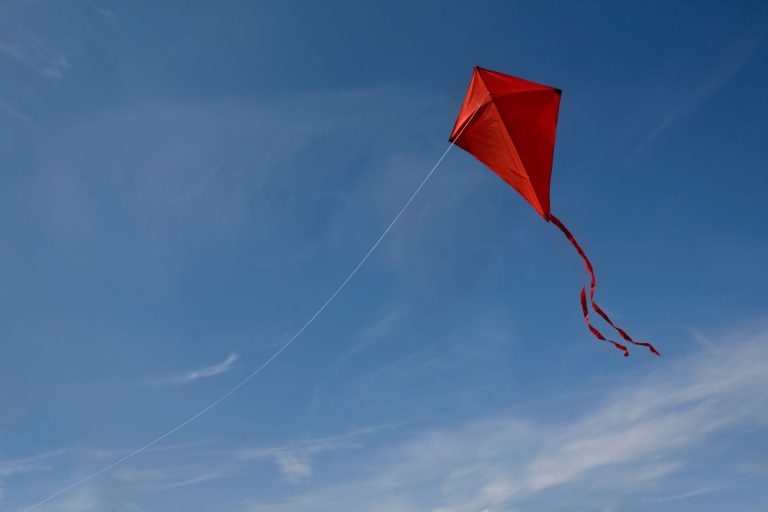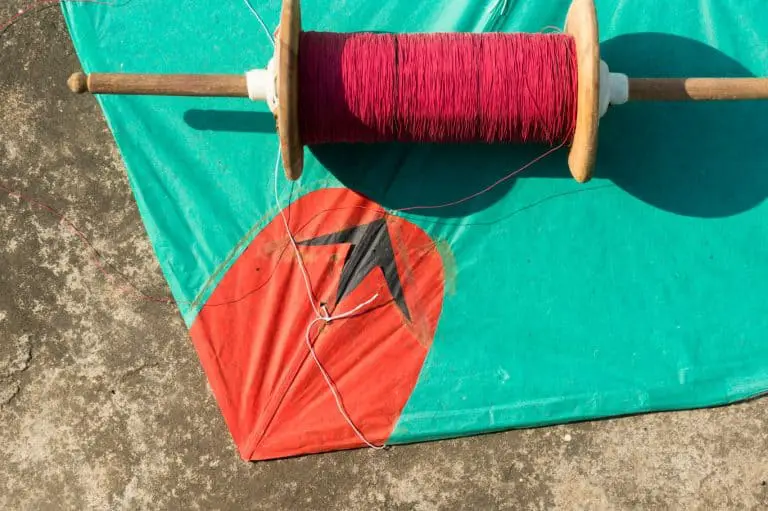A Guide To Balancing A Kite
In the summertime, flying a kite is a popular activity to spend time with friends, family, and kids. The first kite was 2000 years ago, making kite flying a traditional hobby that is easy and fuss-free. It is a great way to clear the mind, have fun, and be creative. It needs only clear weather, and you’re all set.
If you are interested in flying a kite, you may notice that some kites go off-balance and fall to the ground. Though the weather is bright and clear, the kite is still not flying as you want it to be.
You may even wonder how to balance a kite properly. Does the design affect how it flies? Or does it need more tail?
Balancing a kite is a little bit of science. A kite flies because of the wind, and the wind exerts force, lifts the kite, and keeps it in the sky.
This article discusses how to balance a kite and everything you need to know to enjoy the kite-flying activity.
Why Does The Kite Not Fly Away?
Because of many factors such as string, gravity, and the skill of the person flying a kite, the kite seems steady, and the wind cannot blow it away because it is tied to a string. Moreover, the Earth’s gravity naturally pulls the kite straight down.
So, in balancing a kite, there are factors that you must remember, such as:
- The wind that pushes the kite upwards and backward
- The kite string moves the kite forwards and downwards.
- The force of gravity that pulls down to the ground.
As these forces push and pull the kite, the kite may go up. Then, it keeps it in the air or goes out of balance and crashes to the ground. Hence, to balance a kite, these forces must be in balance. When the kite stops still in the sky, it is said to be in equilibrium.
What Are The Different Parts Of The Kite And Their Importance?
Every part of the kite has a purpose. Whether big or small, each kite’s design ensures it will fly. So, it is crucial to know the different details of the kite and how it functions to balance a kite:
Kite Frame Or Spars
Kite frames or spars form the skeleton of the kite and are usually made of rods or sticks. The spar is the spine that runs from the top to the bottom of the kite, while the cross spar is the line that runs horizontally. The entire skeleton of a kite is the frame.
Kite frames and spars determine the location of the balance point, which modifies the kite’s stability. Generally, the balance point should be closer to the nose of the kite concerning the wingtip line or cross spar.
The balance point must be more than 32mm from the wingtip line mark to achieve balance concerning the kite’s weight. This way, it can be easily lifted and launched. Once it reaches a higher level, it will be less likely to spin and more stable.
Bridle
A bridle is the line or arrangement of strings connecting the kite to a flying line and the person. Simply put, the flying line can be a sturdy thread, nylon, or plastic twine that you can hold.
Bridle affects how the kite flies. It is essential to make the overall length appropriate to the weight and size of the kite. You must arrange the string so that the kite hangs at an angle. If you are holding the kite in its string, the nose must be at an angle higher than its lower part.
Should the kite becomes unstable; you need to adjust the segment. You can find the balance by shortening the nose or lengthening the tail segment. Aim for the angle so that it can quickly grasp the wind.
Material Of Kite And Kite Line
The kite materials determine the weight, which may also affect how the kite flies. These materials include fabric, kitchen string, and wooden or bamboo dowels. You can make a kite sail from ripstop nylon, paper, cloth, or recycled plastic bags. In materials, kite makers have more flexibility in the design to make it attractive in the sky.
The materials of the kite can make or break your kite flying. Paper can be light, but it can also tear easily by the wind or rainwater. Fabric may also stretch over time. So, the ideal material for the sail is the plastic bag. Aim for lightweight materials, especially during the days without enough wind.
Kite Tail
A kite tail is the length of ripstop nylon or plastic attached to the bottom of the kite spine. It improves the kite’s visual appeal and helps with stability. The drag caused by the tail makes the kite point in the correct direction.
Some kites do not have kite tails. And that is fine, though; it may result in the kite spinning and rolling a lot.
Keep it around three to eight times the kite’s length when adding a tail. Longer tails may be so heavy that it prevents the kite from flying high, and a shorter tail may not be as effective in keeping the kite stable.
How Is Balance Applied Or Used In A Kite?
Generally, kite flying is compared with air crafts. Analyzing the complexity of flight involves mathematics and physics and the four fundamental physical forces applied in a kite:
Weight And Thrust
Weight pertains to gravity, the force of the Earth that pulls down the kite straight to the ground. The weight acts through the average location of the weight or the center of gravity.
The center of gravity is essential in kite flying and other flying objects. One must uniformly distribute it throughout the kite, or it will tilt and spin. Whatever shape it is, determining the center of gravity modifies the kite’s stability in the air. (source)
Lift
Lift pushes the kite, acts perpendicular to wind flow, and opposes weight. It is generated by density, air velocity, and the angle between the kite surfaces and the wind. The lift is relative to the size and shape of the kite. The lift and drag increase if a gust of wind strikes the kite.
According to Newton’s Third law of motion, every action has an equal and opposite reaction. So, when high-pressure air collides with the kite, the momentum is transferred to the kite. With this action, the kite reacts with a force that pushes the kite away from the air. (source)
Tension Force
The tension force comes from the person that is holding the string. Generally, the kite is heavier than the air and relies on the wind motion that passes through the kite to generate lift. Then, you can overcome it by constraining the kite with a control line. (source)
Drag
Drag is the force that pulls the kite backward. Simply, it resists the movement of the kite through the air. It is in the direction of the wind, opposite the kite’s motion. Drag depends on density and air velocity. In general, the higher the elevation, the lower the density.
These forces must be in equilibrium, regardless of the kite’s size. Whether the kite is small or big, everything should be in balance. When all forces are balanced, the kite sits in the sky.

What Is The Best Shape For A Kite?
There are many different shapes of kites – from the typical diamond shape to out-of-the-ordinary designs like parafoil, box, and cellular. Kite festivals are pretty famous worldwide for showcasing different kite designs.
As a rule, there are three basic kinds of kites:
- Single-Line Kites
The single-line kites are the most basic design. It is a single line because it has one line attached at a central point. It can be a diamond, delta, parafoil, and box-shaped.
- Dual-Line Kites
Two lines control dual-line kites are controlled by two lines that allow the flyer to maneuver the kite up, down, and across the horizon. These kites are a little bit harder to fly.
- Quad-line stunt kites
Quad-line stunt kites are the most versatile kind. It lets you control how the kite flies by moving forward or reverse, flying sideways, pivoting on a wing tip, rotating on dead center, or stopping and hovering mid-air at your chosen speed. However, it is not easy to make, especially for beginners.
The best shape for a kite in all these designs is the classic diamond kite.
The diamond kite is a classic design popular with many kite enthusiasts. It is a single-line kite that is very easy to assemble, so it is suitable for younger kids and beginners. Adding a tail can also be an excellent way to add flair to its design.
What Is The Most Stable Kite?
The kite’s stability depends on the materials, bridle, lines, and forces surrounding the kite. Good weather and the skills of the person holding the kite is also a factor in its stability. However, the kite design is essential to ensure that it will be stable in the sky.
Among these, Delta kites are the most stable. The Delta kite is a typically single-line kite with a modern triangular design that is very eye-catching.
Being single-line kites, delta kites are very easy to set up. Similar to the birds’ wings spread in the sky, the silhouette quickly catches the wind. It is excellent for light winds, making it easier to launch. Even in high winds, Delta kites fly much more stable with lesser kite lines, making them perfect for children and beginners.
Can You Fly A Kite With No Wind?
As a rule, the kite relies heavily on the wind to launch and fly in the sky. However, there are circumstances in which a kite can fly even with no wind.
Defining the wind refers to the airflow from a region of higher pressure to an area of lower pressure. Many obstacles on the ground, such as trees, buildings, plants, etc., cause air friction that slows down the wind. So, current at a higher level when no obstacles are generally stronger than on the ground. (source)
To fly a kite with no wind means it is challenging to launch. The kite type must also be lightweight enough to be lifted and launched. Once launched, the kite must reach a higher level so that even with no wind, the kite will be able to fly and sit in the sky.
What Wind Speed Is Best For Kites?
Without wind, the kite will be tough to launch and fly. While too much wind may launch the kite successfully, it can wreak havoc on the kite and send it crashing down.
According to experts, light breezes of 4-10 miles per hour is the best wind speed for kites. You can easily measure this speed through waving flags, rustling leaves, and when you feel a breeze on your face.
When you have the perfect light breeze to fly a kite, selecting a location that should be wide and open is crucial. Otherwise, there may be turbulence caused by the winds surrounding the obstacles, like trees and buildings, which is not favorable to kite flying.
Read more in my post Best Weather for Kite Flying.
What Do You Call A Kite Without A Tail?
Diamond-shaped and delta kites are popular kites with tails, and some designs have tails to add color and flair. Moreover, the kite tails are essential to the kite’s stability.
The kite tail helps keep the kite become stable by adding drag to the kite. It enables the kite to be pointed in the right direction. It helps avoid kite spinning, veering to one side, or crashing because it is unstable in the air.
However, some kites have no tails. These are called parafoils. Parafoils do not need tails and even have no spars. So they generally rely on winds to hold them open.
Why Will My Kite Not Fly?
Flying a kite may not be easy, and many factors may cause the kite not to fly.
- If the kite does not launch, it may be caused by lacking wind.
- If it launches but sinks head first, there may be too much wind.
- Too much weight on the kite concerning the wind will not make the kite fly.
The kite design may also be the reason why it won’t fly. Knowing how to balance a kite with its materials, frame, and design helps avoid this failure. If you cannot balance the kite in the air, it will not be launched and sit in the sky.
Reasons Why Kite Does Not Fly
- Kite spars are not balanced or may be broken
- Presence of knots, tangles, or twists in the bridle
- Bridle lengths are uneven
- Not enough tension in the kite line
- The incorrect type of kite line leading up to tension problems
- Kite tails weigh uneven, or there is too much weight in the tails attached
Always remember to troubleshoot the kite and keep it at the proper angle. Ensure it is lightweight to allow the air to lift and launch it. Once established, maneuvering the kite becomes easy.
Why Does My Kite Spin In Circles?
The common problem with kite flying is how to balance a kite. When not stable, it spins in circles; once it spins, it will crash down.
As mentioned on how to balance a kite, the four forces of flight, namely weight, drag, thrust, and lift, should be balanced to keep the kite steady. When unsteady, it keeps spinning until it crashes to the ground.
A Kite Will Spin In Circles Because
- The bridle knot is attached near the kite’s top part, making it top-heavy.
- The harness has different lengths that pull the kite in one direction
- The weather has inadequate wind
- Kite passes in the turbulence and gusty winds
- Kite is lacking the tail to add a drag
- Spars are unbalanced
How Do You Make A Kite Fly Better?
Making the kite fly better makes this activity more fun. Knowing the kite’s four forces helps you prepare the best design and schedule the kite flying during the most favorable weather.
Here are some ways to make the kite fly better:
- Attach a decorative tail to add flair while improving its stability.
- Learn how to balance the kite with its frame and other components
- Use the magic of tails by making them long, tiny, and asymmetric
- Constant adjustment of the bridle to find the balance point
- Always remember that the lighter the kite, the better it will fly.
Summary
Flying a kite is a fun activity suitable for kids, teens, friends, and the whole family, especially during summertime. To ensure that the kite flies better and stays in the sky, know how to balance a kite and apply it. Nevertheless, enjoy the process and always have fun!
Sources
- Romano, S. “Kite Engineering with Calculations”, Science Friday. Accessed June 28, 2022. https://www.sciencefriday.com/wp-content/uploads/2017/02/Kite-Engineering-with-Calculations.pdf
- Scott, J. “Science in the Field: Ben Balsley, CIRES Scientist in the Field Gathering atmospheric dynamics data using kites. Kites are anchored to boats on the Amazon River employed to sample levels of certain gases in the air”. 1994. Archived from the original on March 14, 2008. Accessed June 28, 2022. https://web.archive.org/web/20080314091057/http://cires.colorado.edu/science/field/kites/
- Hall, N. “Center of Gravity” National Aeronautics and Space Administration. 2021. Accessed June 28, 2022. https://www.grc.nasa.gov/www/k-12/airplane/cg.html
- Chan, Y. “The Higher the Place, the Stronger the Wind” Hongkong Observatory. 2014. Accessed on June 28, 2022. https://www.hko.gov.hk/en/education/weather/wind-and-pressure/00449-the-higher-the-place-the-stronger-the-wind.html
- Hulslander, M. “How Kites Fly”, Smithsonian National Air and Space Museum, Accessed June 28, 2022. https://airandspace.si.edu/stories/editorial/how-kites-fly







